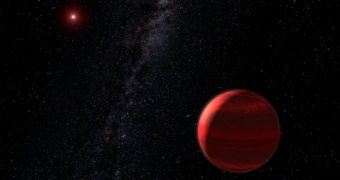An international team of astronomers with the Center for Astrophysics Research at the University of Hertfordshire, working with colleagues in Chile, was recently able to determine that all red dwarf-class stars in the Universe have at least one exoplanetary companion in their orbits.
Since red dwarfs make up no less than 75 percent of all stars in the Cosmos, this implies that exoplanets may be the norm around stars outside of the solar system, rather than the exception. These conclusions are based on the discovery of three super-Earth-class exoplanets in orbits around red dwarfs.
These three worlds are part of a group of eight, but stand out through the fact that they are smaller than Neptune, but larger than Earth. Additionally, the astronomy team has determined that they orbit inside the habitable zone of their parent stars, meaning that liquid water can exist on their surfaces.
The same study also suggests that potentially-habitable super-Earths may orbit around one quarter of all red dwarfs located fairly close to the Sun. These planets all have the potential to host liquid water on their surface, which is thought to be a critical ingredient for the development of life in any form.
The new investigation was led using the High Accuracy Radial velocity Planet Searcher (HARPS) echelle spectrograph instrument on the European Southern Observatory's (ESO) 3.6-meter (12-foot) telescope at La Silla Observatory, in Chile. This instrument has found 130 exoplanets on its own.
The second instrument is the Ultraviolet and Visual Echelle Spectrograph (UVES), an ultraviolet and optical light spectrograph installed on Kueyen, the Unit Telescope 2 at the Very Large Telescope (VLT). The installation is operated by ESO at the Cerro Paranal Observatory, in Chile, Astrobiology Magazine reports.
It was only through combining HARPS and UVES data that the astronomers were able to obtain a signal clear enough to be useful. “We were looking at the data from UVES alone, and noticed some variability that could not be explained by random noise,” says Dr. Mikko Tuomi.
“By combining those with data from HARPS, we managed to spot this spectacular haul of planet candidates,” notes the expert, the lead author of the new study, and a researcher at the CAR. “We are clearly probing a highly abundant population of low-mass planets, and can readily expect to find many more in the near future – even around the very closest stars to the Sun,” Tuomi adds.
The team was not that surprised to discover these alien worlds. Studies conducted using the NASA Kepler planet-hunting space telescope have revealed over the past four years that a significant population of small-radius exoplanets – ranging from Earth analogs to super-Earths – must exist around this class of stars.
All red dwarfs that revealed exoplanetary companions in the new study are located very close to Earth, at distances ranging from 15 to 80 light-years. In the studied planetary population, orbital periods varied between two weeks, for the closest exoplanets to their parent stars, and nine years. This implies orbital distances from 0.05 to 4 astronomical units, or mean Sun-Earth distances.

 14 DAY TRIAL //
14 DAY TRIAL //